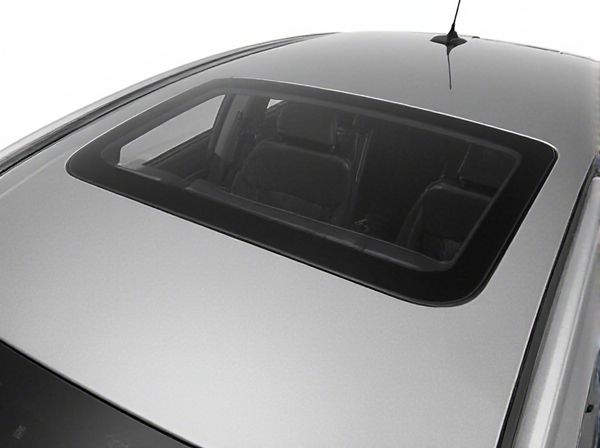
Photo illustration: Moonroof vs Sunroof
A moonroof is a type of sunroof typically made of tinted glass that allows light to enter even when closed, while a sunroof is a solid or glass panel that can be tilted or removed to open the roof completely. Moonroofs often offer a more modern, sleek design and provide a panoramic view, enhancing Your driving experience with natural light. Both features improve ventilation and cabin ambiance, but choosing between them depends on Your preference for openness versus light without full exposure.
Table of Comparison
| Feature | Moonroof | Sunroof |
|---|---|---|
| Description | Transparent or tinted glass panel that slides or tilts open. | Opaque metal or glass panel that slides or tilts open. |
| Material | Glass | Metal or glass |
| Light Entry | Allows natural light even when closed. | Blocks light when closed. |
| Ventilation | Provides good ventilation with tilt option. | Offers ventilation by sliding open. |
| Installation | Factory-installed or aftermarket. | Factory-installed or aftermarket. |
| Cost | Generally higher due to glass and features. | Typically lower than moonroofs. |
| Usage | Popular in modern cars for style and light. | Common in older or budget models. |
Introduction to Moonroof and Sunroof
A moonroof is a glass panel that slides open or tilts to allow light and fresh air into the vehicle, often featuring a tinted or transparent design to provide a panoramic view. A sunroof typically refers to an opaque, metal panel that can be manually or electronically opened to ventilate the cabin but does not usually offer a clear view when closed. Both moonroofs and sunroofs enhance driving comfort and aesthetics by increasing natural light and airflow inside the car.
Key Differences Between Moonroof and Sunroof
Moonroofs feature a glass panel that is typically tinted and can tilt open or slide fully, allowing light while maintaining weather resistance; sunroofs are usually metal or opaque panels that slide open or pop up to let in air and light. Moonroofs often come with an internal sliding shade for controlling light, whereas sunroofs may lack this feature, resulting in less light management. The key difference lies in the material and functionality--moonroofs provide a transparent, light-filtering option, while sunroofs primarily offer ventilation and an open-air experience.
Types of Moonroofs
Moonroofs come in several types, including pop-up, spoiler, inbuilt, and panoramic, each offering distinct features and levels of openness. Pop-up moonroofs tilt open for ventilation, while spoiler moonroofs slide outside the roof to provide enhanced airflow. Panoramic moonroofs span a larger portion of the roof, offering expansive natural light and improved cabin ambiance.
Types of Sunroofs
Sunroofs come in various types, including pop-up, spoiler, and panoramic sunroofs, each offering different benefits for light and ventilation. A pop-up sunroof tilts open to provide airflow without full retraction, while a spoiler sunroof slides open partially, resting on the roof for increased air circulation. Panoramic sunroofs are large, often spanning both front and rear seats, enhancing cabin brightness and openness with fixed or operable glass panels.
Advantages of Moonroofs
Moonroofs offer a sleek, tinted glass panel that provides natural light and an open-air experience without the need to completely open the roof, enhancing comfort and energy efficiency. Unlike traditional sunroofs, moonroofs often feature a sliding or tilting function, allowing better ventilation while maintaining weather protection. These glass panels improve cabin ambiance and visibility, increasing the overall appeal and resale value of the vehicle.
Advantages of Sunroofs
Sunroofs enhance vehicle ventilation by allowing fresh air into the cabin without fully opening the windows, reducing wind noise and turbulence. They offer a customizable open-air experience with options like tilt, slide, or panoramic glass panels that provide natural light while maintaining weather protection. Sunroofs also improve the aesthetic appeal and resale value of a vehicle, making them a popular feature in many modern cars.
Common Materials and Mechanisms
Moonroofs and sunroofs commonly use tempered or laminated glass for durability and safety, though sunroofs may also feature metal panels. Both systems employ sliding or tilting mechanisms powered by electric motors or manual cranks, with sealed tracks to prevent leaks and minimize wind noise. Advanced designs incorporate UV protection coatings and rain sensors to enhance passenger comfort and functionality.
Factors to Consider When Choosing
When choosing between a moonroof and a sunroof, consider factors such as ventilation preferences, transparency, and operation style, as moonroofs typically feature a tinted glass panel that lets in light even when closed, whereas sunroofs are often opaque and fully retractable to open the roof entirely. Vehicle design compatibility and weather resistance are crucial since moonroofs offer permanent covers reducing water seepage risk, while sunroofs may require additional sealing for rain protection. Cost and maintenance also play a role: moonroofs tend to be more durable with fewer mechanical parts, whereas sunroofs might need frequent servicing due to their sliding mechanisms.
Cost Comparison: Moonroof vs Sunroof
Moonroofs typically cost between $500 and $1,200, depending on the make and model, while sunroofs can range from $300 to $1,000. Moonroofs, often made of tinted glass panels, generally have higher installation and maintenance costs due to their complex mechanisms and materials. Sunroofs, usually opaque and manually operated or simple sliding panels, tend to be less expensive but may offer fewer features and reduced aesthetic appeal.
Maintenance and Durability
Moonroofs, typically made of tinted glass, require regular cleaning with non-abrasive materials to maintain clarity and prevent seal deterioration, ensuring long-term durability. Sunroofs, often constructed from metal or opaque panels, need periodic lubrication of mechanical parts to avoid rust and mechanical wear, extending their lifespan. Both require routine inspection of seals and drainage channels to prevent leaks and maintain optimal functionality.
 caratoz.com
caratoz.com